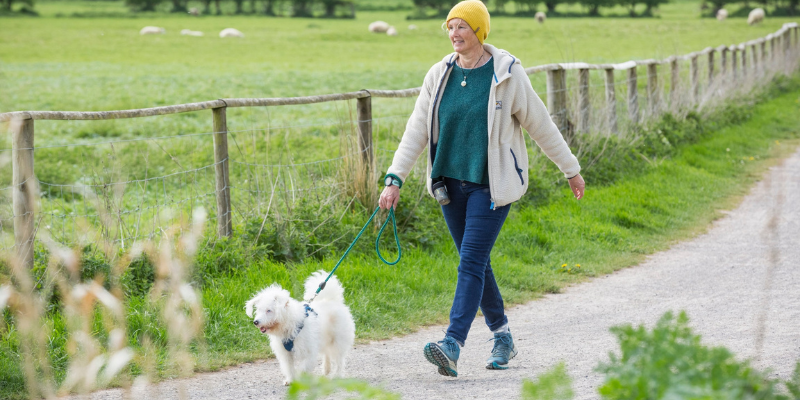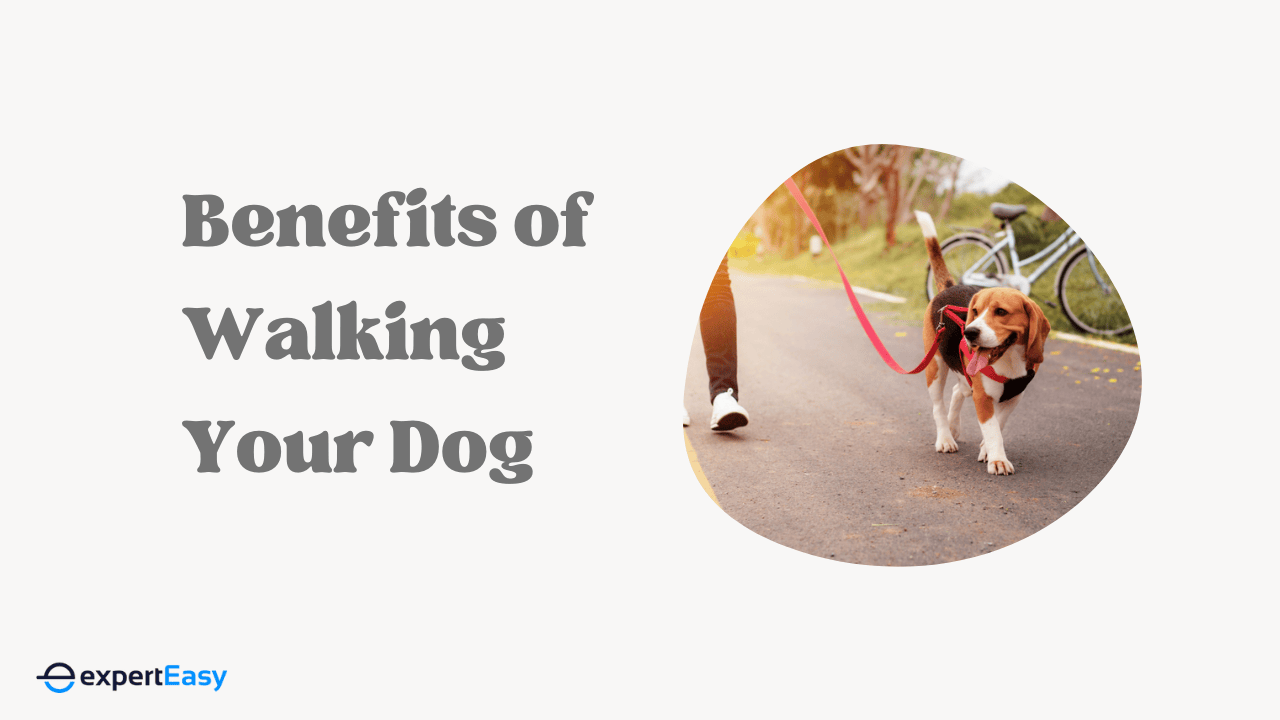Walking with a dog is a popular and enjoyable activity for many pet owners. Not only does it provide an opportunity for bonding with your furry friend, but it can also be a great way to improve your physical fitness.
In this article, we'll cover why walking with your dog can be a great addition to your fitness routine, from burning calories and strengthening muscles to reducing stress and improving cardiovascular health.
Walking is a low-impact exercise, which when done regularly, can have significant health benefits. But before then, we'll look at how it affects dogs. Only so you do not overwalk them, trying to get fit.
How Much Walking Do Dogs Need?
The ideal amount of daily activity for dogs is not a one-size-fits-all standard, as it varies depending on the age and breed of your dog. Typically, the recommended daily exercise time falls between 30 and 120 minutes. Thus, it is essential to ensure that the pace and duration of the walk are appropriate for the dog's breed. Energetic breeds such as Labradors, German Shepherds, and Golden Retrievers are typically enthusiastic about lengthy, brisk walks until they reach a more advanced age.
On the other hand, less active breeds, like Pugs with flattened noses that make breathing difficult, may not be keen on taking lengthy or fast walks. These dogs may tire easily, slow down, and even whimper when they want to return home. In these cases, take shorter walks at more frequent intervals rather than one long walk per day.
If you plan on doing a long hike or walk on a hot day then make sure you bring water and a bowl for your furry friend. During hotter days, you must also be mindful of the surface you walk on. Pavement can become excessively hot and cause severe burns to your dog’s paws. To test, place your bare foot or hand on the pavement. If you can't hold it there for ten seconds, the pavement is too hot for your dog to walk on.
Physical Benefits of Walks With Your Dog

Dogs make excellent personal trainers as they are always eager to go for a walk, are tirelessly hard-working, and have sad, pleading eyes that can be a powerful motivator to get moving. Here are the essential benefits of walking with a dog to improve your physical fitness.
#1 - Increase Physical Fitness
Regular exercise is essential to achieving physical fitness. Walking helps to build strength and endurance in muscles. Regular walking can increase muscle mass, tone, and strength in the legs, hips, and buttocks.
Walking engages multiple muscle groups, including the legs, core, and upper body. This helps to increase muscle strength and endurance, leading to improved physical fitness. Walking also helps to improve flexibility, as it requires your muscles to stretch and contract with each step. This can lead to an increased range of motion and improved posture.
#2 - Reduce the Risk of Cardiovascular Disease
Unfortunately, several dogs face health issues such as obesity due to insufficient exercise and overfeeding. Regular walks effectively address this problem and promote cardiovascular health for you and your canine companion.
Regular physical activity, such as walking with your dog, can help keep your cardiovascular system healthy by improving blood circulation, reducing inflammation, and lowering blood pressure and cholesterol levels. In fact, the CDC recommends that adults engage in at least 20 minutes of exercise per day.
While 20 minutes of walking is a good start, many dogs may require additional activity to meet their daily exercise needs. Depending on your dog’s age and breed, long walks, jogs, or backyard playtime may be necessary. Consult with your veterinarian to determine the appropriate amount of daily exercise for your dog.
#3 - Improves Balance
As individuals age, their sense of balance tends to decline. Most often compounded by certain medical conditions, medications, and a lack of flexibility, which can lead to an increased risk of falling. Depending on your terrain when you walk your dog, you are likely to use uneven roads, such as sidewalks, trails, or grass which can help improve your balance as you constantly adjust your body to maintain your footing.
In addition, walking with a dog also improves your core strength and coordination since you constantly engage your core muscles to maintain your balance, adapt to changes in the environment, and control your movements.
#4 - Helps Burn Calories
The number of calories burned while walking a dog varies based on the dog's pace and behaviour. On average, an individual of moderate weight can burn approximately 205 calories per hour while walking a dog at a relaxed speed of 2 miles per hour, accounting for stops for the dog's bathroom breaks and exploration. If the dog is inclined to walk quickly and pull on the leash, you may burn more calories trying to keep up with its pace.
Although 205 calories may seem insignificant, they can accumulate over time. Walking a dog for an hour each day of the week can result in burning 1435 calories during a time when you could have been sedentary. It only takes burning 3500 calories to shed 450 grams, so after a week of dog walking, you are nearly halfway towards 1 kg.
It is important to note that individuals with a higher body weight will burn more calories while walking a dog. Additionally, there are methods to enhance the number of calories burned, including walking uphill or increasing the pace.
#5 - Improved Immune System
Walking with your dog gets you outside in the fresh air and sunshine. Exposure to natural sunlight helps the body produce vitamin D, which is essential for a healthy immune system. Vitamin D deficiency has been linked to an increased risk of infections, including respiratory infections such as colds and flu.
A strong immune system helps the body fight off infections and illnesses and helps prevent diseases from developing in the first place. Exercise is one of the best ways to boost the immune system, and walking with your dog is an easy and enjoyable way to get regular exercise.
You can also support your immune system while walking with your dog with healthy snacks to your energy levels up, such as fruit, nuts, or trail mix. And to stay hydrated, always carry a water bottle along.
#6 - Improved Digestion
Good digestion allows the body to absorb nutrients from food and eliminate waste products efficiently. Walking with your dog can help improve digestion in several ways.
First, physical exercise stimulates the digestive system, helping to move food through the digestive tract more efficiently. It helps reduce constipation and bloating, which is uncomfortable and sometimes painful. Regular exercise has also been shown to help reduce the risk of digestive diseases such as irritable bowel syndrome (IBS) and inflammatory bowel disease (IBD).
Additionally, walking your dog improves digestion by reducing stress levels. Stress is linked to digestive problems such as acid reflux, ulcers, and stomach cramps. The time spent with your dog outside, enjoying the beautiful outdoors can help reduce stress levels and promote relaxation, which can have a positive impact on digestion.
#7 - Increased Energy Levels
Walking with your dog can help reduce the feeling of tiredness or sluggishness that is common with people who have busy schedules, long to-do lists, and live sedentary life.
Good exercise, including walking, is known to boost energy levels by increasing circulation and oxygen flow throughout the body. This helps reduce fatigue and improve alertness and concentration. Exercise also stimulates the production of endorphins, which are natural feel-good chemicals that can improve mood and increase energy levels.
Additionally, walking your dog can improve your sleep quality, which is essential for good energy levels. Regular exercise has been shown to help improve sleep patterns, and spending time outside in the fresh air and sunlight can help regulate the body's natural sleep-wake cycle.
Community Health Benefits of Dog Walking and Pet Ownership

Dog walking and pet ownership are more than physical fitness. These activities also have far-reaching benefits for entire communities. By promoting dog walking and responsible pet ownership, communities can enjoy several health benefits that make them more robust and connected.
#1 - Promoting Physical Activity
Promoting physical activity is essential in improving overall health in a community. People who engage in regular exercise are less likely to experience chronic illnesses, such as diabetes, heart disease, and obesity.
Dog walking is an excellent form of exercise, especially for people who are not motivated to work out. It provides a sense of purpose and accountability, as dogs need to be walked every day. Dog owners are more likely to achieve the recommended level of physical activity compared to non-dog owners.
Communities should promote dog walking by providing suitable environments for it. Parks and other green spaces are excellent venues for dog walking.
#2 - Improving Mental Health
Pets can have a profound impact on people’s mental health, providing companionship and reducing loneliness. The mental health benefits of pet ownership are especially important in a community context, where social isolation and loneliness can be significant problems.
Communities can promote pet ownership by encouraging responsible pet ownership and information on adequate pet care, such as nutrition, exercise, and socialization. Communities should also provide opportunities for pet owners to meet and connect to foster social connections that support mental health.
#3 - Strengthening Social Connections
Social connections are essential for the overall health of a community. People who feel connected to their community are more likely to experience better health outcomes, including lower rates of chronic diseases. Pet ownership, particularly dog ownership, provides opportunities for people to connect and form new friendships.
Final Words
Walking with a dog has numerous benefits for the dog and its owner. Not only does it help establish a stronger bond between the two, but it also contributes to better physical fitness.
Regular walking with a dog can aid in weight management, improve cardiovascular health, increase endurance and stamina, and reduce the risk of chronic diseases. It is also a low-impact exercise that people of all ages and fitness levels can enjoy.
So, whether you are a seasoned fitness enthusiast or just looking for a fun way to stay active, strolling with your dog is an excellent way to improve your physical fitness and overall well-being.







